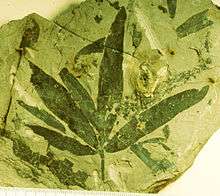Sagenopteris
Sagenopteris is a genus of extinct seed ferns from the Triassic to late Early Cretaceous.[1][2]
| Sagenopteris | |
|---|---|
 | |
| Sagenopteris phillipsii leaves, Middle Jurassic, Gristhorpe Bed, Cloughton Formation, Cayton Bay, Yorkshire. | |
| Scientific classification | |
| Kingdom: | Plantae |
| Clade: | Tracheophytes |
| Division: | †Pteridospermatophyta |
| Order: | †Caytoniales |
| Family: | †Caytoniaceae |
| Genus: | †Sagenopteris Presl 1838 |
| Species | |
|
See text | |
Description
Sagenopteris has palmately arranged leaves with anastomosing venation.
Different organs attributed to the same original plant can be reconstructed from co-occurrence at the same locality and from similarities in the stomatal apparatus and other anatomical peculiarities of fossilized cuticles.
- Sagenopteris phillipsii may have been produced by the same plant as Caytonia nathorstii (ovulate organs) and Caytonanthus arberi (pollen organs).[3]
Species
The following species have been described:[1]
- Sagenopteris colpodes
- Sagenopteris elliptica
- Sagenopteris mclearni
- Sagenopteris nilssoniana
- Sagenopteris oregonensis
- Sagenopteris phillipsii
- Sagenopteris variabilis
- Sagenopteris williamsii
- Sagenopteris trapialensis[2]
Distribution
Fossils of Sagenopteris have been registered in:[1]
- Triassic
Argentina, China, Germany, Greenland, Italy, Japan, Kyrgyzstan, the Russian Federation, Sweden, Tajikistan, Ukraine, United States (Virginia, Virginia/North Carolina).
- Jurassic (to Cretaceous)
Afghanistan, Antarctica, Argentina, Azerbaijan, Belarus, Canada (British Columbia, Yukon), China, Colombia (Valle Alto Formation, Caldas), Georgia, Germany, Greenland, India, Iran, Italy, Japan, Kazakhstan, Kyrgyzstan, Mexico, Peru, Poland, Romania, the Russian Federation, Tajikistan, Turkmenistan, Ukraine, the United Kingdom, United States (Alaska, Montana, Oregon/Idaho), and Uzbekistan.
- Cretaceous
Belgium, Canada (British Columbia), Greenland, the Russian Federation, and the United States (Montana).
References
- Sagenopteris at Fossilworks.org
- Elgorriaga, A.; Escapa, I. H.; Cúneo, R. (2019). "Southern Hemisphere Caytoniales: vegetative and reproductive remains from the Lonco Trapial Formation (Lower Jurassic), Patagonia". Journal of Systematic Palaeontology. doi:10.1080/14772019.2018.1535456.
- Retallack, G.J. & Dilcher, D.L. (1988). "Reconstructions of selected seed ferns". Missouri Botanical Garden Annals. 75: 1010–1057.